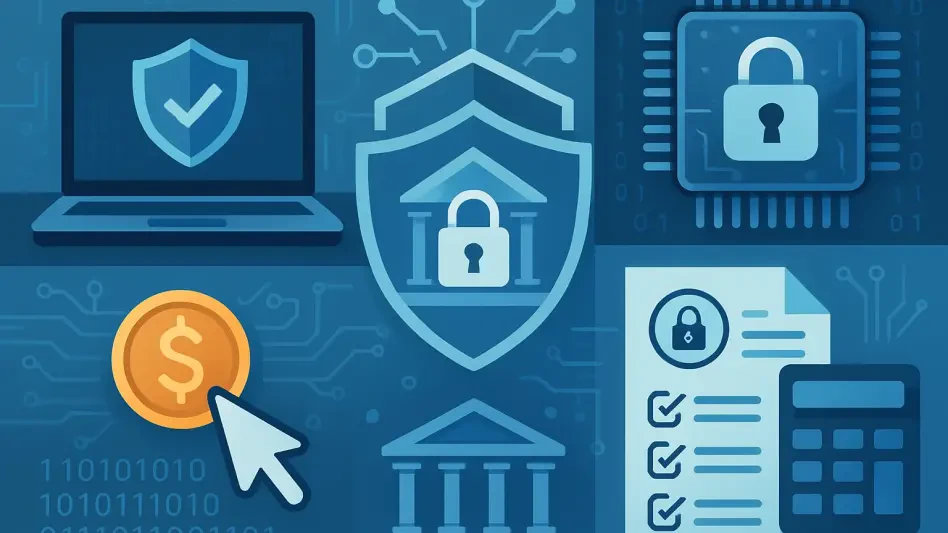In an era where digital threats loom larger than ever, imagine a financial advisory firm facing a devastating data breach, compromising sensitive client information and triggering severe penalties from regulatory bodies. This scenario is no longer just a hypothetical risk but a pressing reality for registered investment advisors (RIAs) navigating the stringent cybersecurity mandates imposed by the Securities and Exchange Commission (SEC). The importance of robust cybersecurity solutions has skyrocketed as these regulations demand written plans and swift incident reporting. This FAQ article aims to address critical questions surrounding cybersecurity compliance for financial advisory firms, offering clear guidance and actionable insights. Readers can expect to explore key challenges, evaluate specialized solutions, and understand how to safeguard their operations while meeting regulatory requirements.
Key Questions on Cybersecurity Compliance
What Are the SEC’s Cybersecurity Requirements for Financial Advisors?
The SEC has introduced specific cybersecurity rules that mandate RIAs to establish formal, documented cybersecurity programs. These regulations require firms to identify risks, protect client data, detect potential threats, respond to incidents, and recover from breaches effectively. Non-compliance can lead to significant fines and reputational harm, making adherence a top priority for any advisory business. The challenge lies in the complexity of these requirements, particularly for smaller firms that may lack dedicated IT resources or expertise to implement such measures independently.
This regulatory framework emphasizes the need for a proactive stance against cyber threats, pushing advisors to integrate comprehensive strategies into their operations. Solutions often involve third-party providers who can assist in drafting policies and setting up monitoring systems. For instance, aligning with established standards like the National Institute of Standards and Technology (NIST) framework can provide a structured approach to meeting these obligations. The urgency to comply is underscored by the increasing sophistication of cyberattacks, which demands constant vigilance.
Why Is Cybersecurity Compliance Critical for Financial Advisory Firms?
Cybersecurity compliance is not merely about avoiding penalties; it serves as a cornerstone for maintaining client trust and ensuring business continuity. A single breach can erode years of goodwill, exposing personal and financial data to malicious actors. For RIAs, the stakes are even higher due to the sensitive nature of the information they handle, such as investment portfolios and personal identifiers, which are prime targets for cybercriminals.
Beyond trust, compliance helps firms mitigate operational disruptions that could arise from ransomware or phishing attacks. The financial sector remains one of the most targeted industries, with studies showing a steady rise in data breaches over recent years. Implementing robust cybersecurity measures acts as a shield, reducing the likelihood of costly interruptions and preserving a firm’s ability to serve clients effectively during crises.
What Challenges Do RIAs Face in Achieving Cybersecurity Compliance?
Achieving compliance poses significant hurdles for RIAs, especially for smaller or newly established firms with limited budgets and staff. The technical complexity of cybersecurity—ranging from encryption protocols to real-time threat detection—often requires specialized knowledge that in-house teams may not possess. Additionally, the evolving nature of cyber threats means that solutions must be updated regularly, adding to the resource strain.
Another challenge lies in managing third-party vendors, who often play a critical role in a firm’s technology ecosystem but can introduce vulnerabilities if their security practices are lax. Balancing these external risks with internal training needs further complicates the compliance journey. Many firms struggle to allocate time and funds toward fostering a culture of awareness among employees, despite human error being a leading cause of breaches.
What Types of Cybersecurity Solutions Are Available for RIAs?
A wide array of cybersecurity solutions exists to support RIAs in meeting SEC requirements, ranging from risk assessments to incident response planning. Providers offer tools like phishing simulations to test employee readiness and data discovery systems to pinpoint vulnerabilities within a firm’s infrastructure. Managed security services, including real-time monitoring and intrusion detection, are also common, ensuring threats are addressed before they escalate.
Some solutions focus on specific areas, such as email security to combat targeted attacks or cloud protection for firms relying on digital storage. Others adopt a more holistic approach, integrating multiple aspects like policy development, staff training, and business continuity planning into a single package. The diversity of options allows firms to select services that match their size, risk profile, and budget constraints, ensuring tailored protection.
How Can Financial Advisors Choose the Right Cybersecurity Provider?
Selecting a cybersecurity provider requires careful evaluation of several factors to ensure alignment with a firm’s unique needs. Advisors should consider the scope of services offered, looking for providers that address critical areas like regulatory compliance, vendor management, and employee education. Pricing transparency and the availability of customer support are equally important, as hidden costs or inadequate assistance can hinder effective implementation.
Reputation and compatibility with existing technology also play a vital role in the decision-making process. Firms are encouraged to seek providers with proven track records in the financial sector and systems that integrate seamlessly with current operations. Conducting thorough due diligence, such as requesting demos or reviewing case studies, can provide valuable insights into a provider’s reliability and effectiveness in delivering compliance solutions.
What Role Does Employee Training Play in Cybersecurity Compliance?
Employee training stands as a fundamental pillar of cybersecurity compliance, addressing the human element often exploited in cyberattacks. Many breaches stem from simple mistakes, such as clicking on malicious links or failing to recognize phishing attempts, highlighting the need for ongoing education. Training programs equip staff with the skills to identify and respond to threats, reducing the risk of accidental data exposure.
Effective training goes beyond one-time sessions, incorporating regular updates and simulations to reinforce best practices. Providers often include modules on password management, secure data handling, and incident reporting as part of their offerings. Cultivating a culture of vigilance ensures that employees become the first line of defense, complementing technological safeguards with informed decision-making.
How Does Technology Enhance Cybersecurity for Financial Advisory Firms?
Advanced technology significantly bolsters cybersecurity efforts for financial advisory firms by enabling rapid detection and response to threats. Tools powered by artificial intelligence, such as threat detection systems, can analyze patterns and flag anomalies in real time, staying ahead of sophisticated attacks. Managed security information and event management (SIEM) services provide continuous monitoring, offering a comprehensive view of a firm’s digital environment.
Beyond detection, technology facilitates secure data storage and communication through encryption and secure endpoints. These innovations are particularly crucial for firms adopting cloud-based systems or remote work arrangements, where exposure risks are heightened. Leveraging such tools not only strengthens defenses but also demonstrates a commitment to compliance during regulatory audits, enhancing overall credibility.
Summary of Key Insights
This discussion has unpacked the essential aspects of cybersecurity compliance for financial advisory firms, addressing the SEC’s stringent requirements and the importance of safeguarding client data. Key challenges, including resource limitations and third-party risks, have been highlighted alongside a variety of available solutions tailored to RIAs’ needs. The role of employee training and advanced technology in fortifying defenses has been emphasized, as has the necessity of choosing a provider that aligns with specific operational goals. These insights underscore that compliance is a continuous journey, requiring proactive measures and strategic partnerships. For deeper exploration, readers may consider consulting resources from regulatory bodies like the SEC or industry frameworks such as NIST to further enhance their understanding and implementation strategies.
Final Thoughts
Reflecting on the journey through cybersecurity compliance, it becomes evident that financial advisory firms face mounting pressures to protect sensitive data while adhering to rigorous SEC mandates. The exploration of various solutions and provider options reveals a landscape rich with opportunities to strengthen defenses. Moving forward, advisors should prioritize actionable steps, such as initiating risk assessments or engaging with specialized providers to craft customized cybersecurity plans. Consideration of long-term strategies, including periodic policy reviews and technology upgrades from this year to 2027, will ensure resilience against emerging threats. Ultimately, integrating compliance into the core of business operations not only mitigates risks but also positions firms to build lasting trust with clients in an increasingly digital world.








